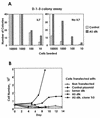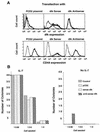Modulated expression of the epidermal growth factor-like homeotic protein dlk influences stromal-cell-pre-B-cell interactions, stromal cell adipogenesis, and pre-B-cell interleukin-7 requirements
- PMID: 9710609
- PMCID: PMC109110
- DOI: 10.1128/MCB.18.9.5247
Modulated expression of the epidermal growth factor-like homeotic protein dlk influences stromal-cell-pre-B-cell interactions, stromal cell adipogenesis, and pre-B-cell interleukin-7 requirements
Abstract
A close relationship exists between adipocyte differentiation of stromal cells and their capacity to support hematopoiesis. The molecular basis for this is unknown. We have studied whether dlk, an epidermal growth factor-like molecule that intervenes in adipogenesis and fetal liver hematopoiesis, affects both stromal cell adipogenesis and B-cell lymphopoiesis in an established pre-B-cell culture system. Pre-B-cell cultures require both soluble interleukin-7 (IL-7) and interactions with stromal cells to promote cell growth and prevent B-cell maturation or apoptosis. We found that BALB/c 3T3 fibroblasts express dlk and function as stromal cells. Transfection of these cells with antisense dlk decreased dlk expression and increased insulin-induced adipocytic differentiation. When antisense transfectants were used as stroma, IL-7 was no longer required to support the growth of pre-B cells and prevent maturation or apoptosis. Antisense dlk transfectants of S10 stromal cells also promoted pre-B-cell growth in the absence of IL-7. These results show that modulation of dlk on stromal cells can influence their adipogenesis and the IL-7 requirements of the pre-B cells growing in contact with them. These results indicate that dlk influences differentiation signals directed both to the stromal cells and to the lymphocyte precursors, suggesting that dlk may play an important role in the bone marrow hematopoietic environment.
Figures







References
-
- Aaronson S A, Todaro G J. Development of 3T3-like lines from Balb-c mouse embryo cultures: transformation susceptibility to SV40. J Cell Physiol. 1968;72:141–148. - PubMed
-
- Artavanis-Tsakonas S, Matsuno K, Fortini M E. Notch signaling. Science. 1995;268:225–232. - PubMed
-
- Bauer S R, Scheuermann R H. Expression of the VpreB/5/pseudo-Ig complex correlates with downregulated RAG-1 expression and V(D)J type recombination: a mechanism for allelic exclusion at the IgH locus. Transgenics. 1993;1:33–45.
-
- Boone C W, Scott R E. Plate-induced tumors of BALB/3T3 cells exhibiting foci of differentiation into pericytes, chondrocytes, and fibroblasts. J Supramol Struct. 1980;14:233–240. - PubMed
-
- Chomczynski P, Sacchi N. Single-step method of RNA isolation by acid guanidinium thiocyanate-phenol-chloroform extraction. Anal Biochem. 1987;162:156–159. - PubMed
MeSH terms
Substances
LinkOut - more resources
Full Text Sources
Other Literature Sources
